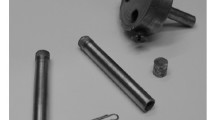The results of laboratory tests for drilling of corundum, chamotte, and porcelain with diamond tubular drills in running water, as well as the friction of cylindrical samples of the matrix against these materials, have been described. Bronze containing ultrafine ASM 1/0 diamond powders and molybdenum, as well as bronze without this reinforcement, served as the matrix for the drills and cylindrical samples. The speed of processing corundum, chamotte, and porcelain with diamond drills constantly increased when the concentration of diamond powders raised to 11 wt.%. At the same time, the tool wear significantly reduced, reaching the minimum at 5–9 wt.% of ASM 1/0 concentration (depending on the choice of the test material). The wear of diamond powder increased binsignificantly when the concentration of diamond powders grew to 11 wt.%. Similar results were obtained for the matrix of samples. Thus, the wear of the matrix samples decreased with an increase in the ASM 1/0 concentration. Such a decrease was observed even at 11 wt.% for friction against corundum. During friction against chamotte and porcelain, the wear of the samples reached the minimum at 7 wt.% diamond powders. As in the case with drills, a further increase in the content of ASM 1/0 in the reinforcement led to an increase in wear of the samples. High wear of the drills and samples at a relatively high content (11 wt.%) of ultrafine diamond powders was explained by the porosity that occurred in the matrix. The studies performed allowed concluding that reinforcement containing ultrafine ASM 1/0 diamond and molybdenum powders should be introduced into the matrix of diamond drills to improve their performance and decrease the consumption of abrasive material. The matrix samples containing up to 7 wt.% of ultrafine diamond powders can be successfully used as an abrasive tool for finishing (polishing) a series of nonmetallic materials, in particular, semiprecious and precious stones in jewelry production.




Similar content being viewed by others
References
V.N. Bakul, Basics of Design and Manufacturing Technology of Abrasive and Diamond Tools [in Russian], Mashinostroenie, Moscow (1975), p. 297.
Yu.V. Naidich, G.A. Kolesnichenko, I.A. Lavrinenko, and Ya.F. Motsak, Soldering and Metal Plating of Superhard Tool Materials [in Russian], Naukova Dumka, Kyiv (1977), p. 186.
D. Evans, M. Nicholas, and P. Scott, “The wetting and bonding of diamonds by copper titanium alloys,” Ind. Diamond Rev., No. 9, 306–309 (1977).
A.A. Bugaev, V.N. Livshits, and V.V. Ivanov, Synthetic Diamonds in Geological Prospecting Drilling [in Russian], Naukova Dumka, Kyiv (1978), p. 232.
N.V. Novikov (ed.), Synthetic Superhard Materials, Vol. 2, Composite Tool Superhard Materials [in Russian], Naukova Dumka, Kyiv (1986), p. 264.
Yu.V. Naidich, V.P. Umanskii, and I.A. Lavrinenko, Strength of the Diamond—Metal Interface and Brazing of Diamonds, Cambridge International Science Publishing (2007), p. 160.
V.P. Umanskii, “The impregnation technique of micro- and ultrafine diamond powders in the manufacture of tools,” Ukrainian Patent 120657, publ. January 10 (2020), Bulletin No. 1.
V.P. Umanskii, “Improved performance of diamond tube drills due to chromium metalization,” Adgezia Rasplavov, 40, p. 92–102 (2007).
Author information
Authors and Affiliations
Corresponding author
Additional information
Translated from Poroshkova Metallurgiya, Vol. 59, Nos. 7–8 (534), pp. 152–160, 2020.
Rights and permissions
About this article
Cite this article
Umansky, V., Brodnikovskiy, N., Bashchenko, O. et al. The Effect of Matrix and Processed Material Properties on the Performance of Diamond Drills. Powder Metall Met Ceram 59, 477–482 (2020). https://doi.org/10.1007/s11106-020-00181-2
Received:
Published:
Issue Date:
DOI: https://doi.org/10.1007/s11106-020-00181-2




